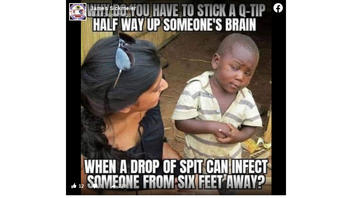
Is the Q-tip nasal swab for COVID-19 that is stuck "up someone's brain" equivalent to "a drop of spit" that can infect someone from six feet away? No, that's not true. A single virus can hatch an infection, while a much bigger sample is needed for accurate testing. A drop of spit can infect a person because a virus riding that airborne spray attaches to the new host body, copies itself and multiplies throughout the newly-infected host, which takes time. Testing, which emphasizes fast reports, requires a larger sample.
The claim appeared as a post (archived here) where it was published on Facebook on November 23, 2020. It opened:
"Why do you have to stick a q-tip up someone's brain when a drop of spit can infect someone six feet away?"
This is what the post looked like on Facebook at the time of writing:
(Source: Facebook screenshot taken on Fri Dec 4 23:12:40 2020 UTC)
The nasal swab and the aerosolized spittle that infects a person with COVID-19 carry very different viral loads, said Dr. Otto Yang, a professor of medicine in the infectious diseases division at the David Geffen School of Medicine at UCLA . In a December 18, 2020 email to Lead Stories, Yang put it in stark terms: "The amount that is needed to cause an infection (one virus) is far less than a test can detect, and so you need an adequate sampling." The biggest estimated size of a COVID viron is 200 nanometers, so 400 could rest on the blunt tip of a human hair.
Brian Mochon, PhD, a clinical microbiologist and system medical director at Sonora Quest Laboratories/Laboratory Sciences of Arizona for infectious disease testing, explained why the nasal swab, or the nasopharyngeal swab is the best way to achieve a reliable COVID test.
"Samples pulled from deeper in the nasopharynx have proven to have a higher viral concentration or titer," he told Banner Health. "In other words, you are more likely to obtain a more accurate diagnosis when sampling with the nasopharyngeal (NP) swabs than you are with a nasal or throat swab."
The claim that a "drop of spit can infect someone six feet away," is accurate but does not carry enough viruses to be easily tested to determine whether or not a person has COVID-19. A virus only needs a small amount to enter the body, it then multiplies and spreads through the body.
From WebMd:
How Does Coronavirus Attack Your Body?
A virus infects your body by entering healthy cells. There, the invader makes copies of itself and multiplies throughout your body.
The new coronavirus latches its spiky surface proteins to receptors on healthy cells, especially those in your lungs.
Specifically, the viral proteins bust into cells through ACE2 receptors. Once inside, the coronavirus hijacks healthy cells and takes command. Eventually, it kills some of the healthy cells.
The National Center for Biotechnology Information explained "How How Infection Works" in an article:
Viruses are tiny, ranging in size from about 20 to 400 nanometers in diameter (see page 9). Billions can fit on the head of a pin. Some are rod shaped; others are round and 20 sided; and yet others have fanciful forms, with multisided "heads" and cylindrical "tails."
Viruses are simply packets of nucleic acid, either DNA or RNA, surrounded by a protein shell and sometimes fatty materials called lipids. Outside a living cell, a virus is a dormant particle, lacking the raw materials for reproduction. Only when it enters a host cell does it go into action, hijacking the cell's metabolic machinery to produce copies of itself that may burst out of infected cells or simply bud off a cell membrane. This lack of self-sufficiency means that viruses cannot be cultured in artificial media for scientific research or vaccine development; they can be grown only in living cells, fertilized eggs, tissue cultures, or bacteria.
















